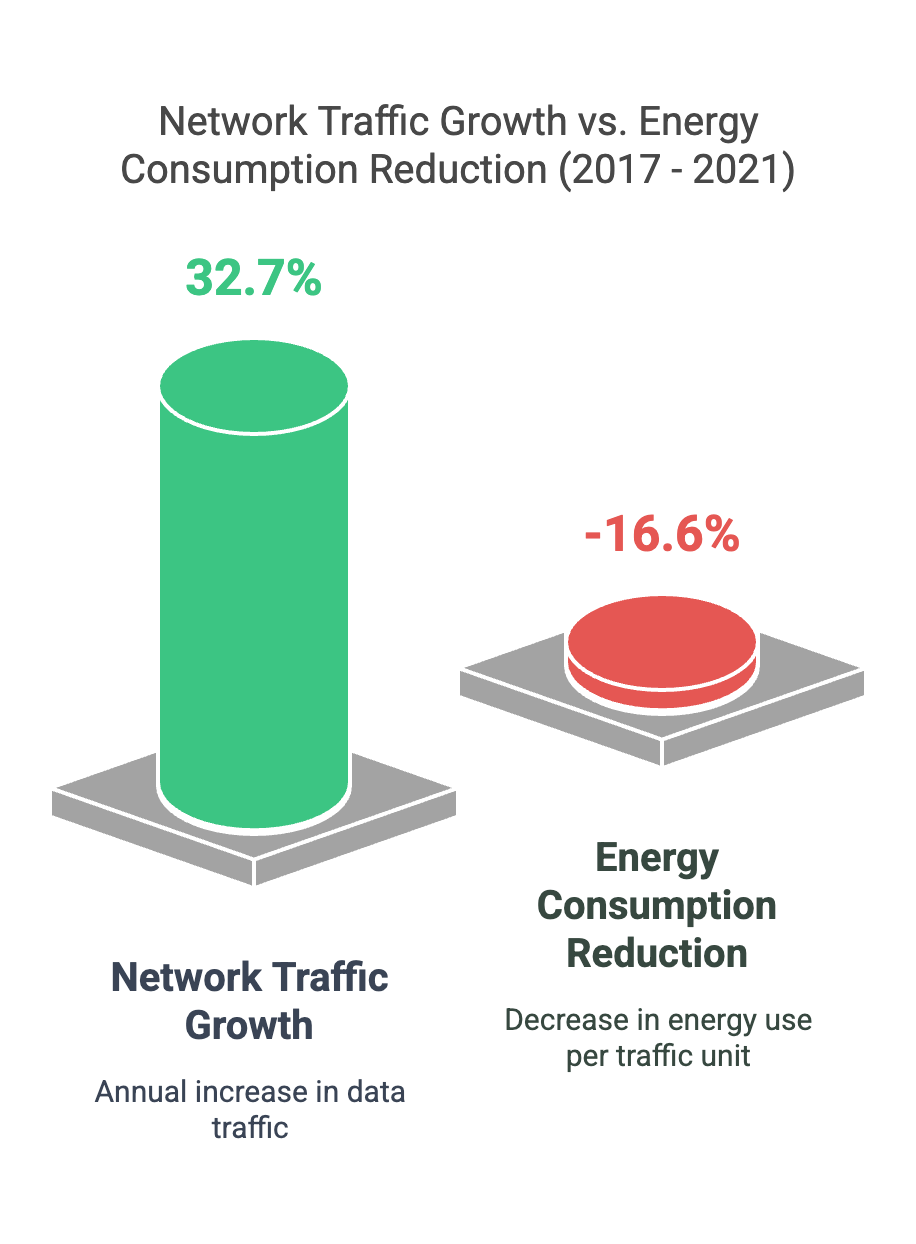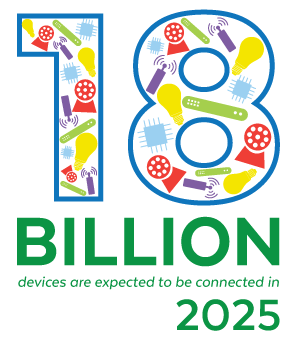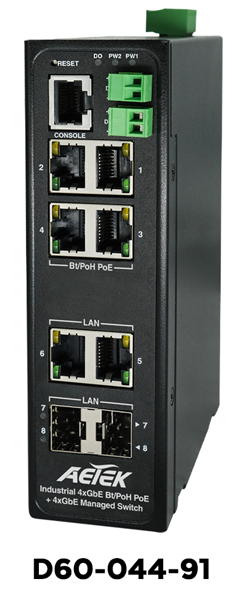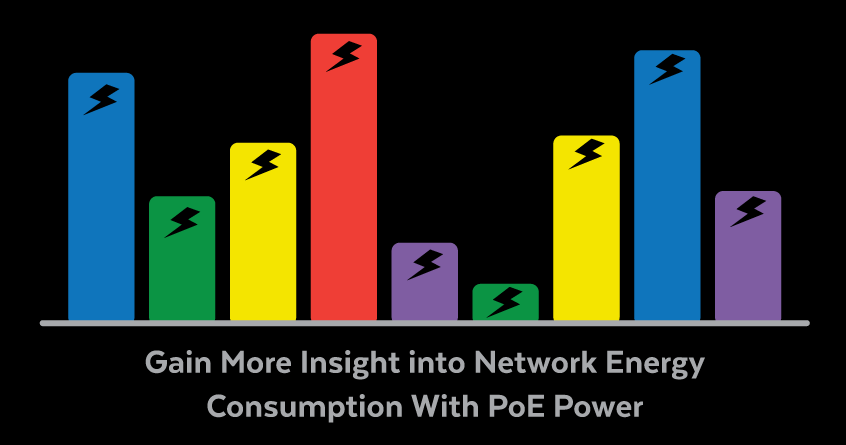The energy a network consumes depends on its size, configuration, and workload. However, recent research challenges the old assumption that the more extensive a network, the higher its energy consumption. Energy use is not always proportional to network size alone. Network administrators should not estimate power consumption based solely on data volumes. Instead, accurate calculations of energy usage in a network require looking at the network’s components. To get a comprehensive and accurate understanding of energy consumption, one must consider the network in terms of segments. Segmentation might include examining the end user, network devices, data transmission, and data infrastructure as individual components. This level of granular focus can guide network engineers as they configure networks to balance performance with sustainability and user experience with cost. Incorporating power-over-Ethernet (PoE) technology allows IT departments to leverage PoE power to reduce energy consumption at the device level.
Network Size and Workloads

Network size usually refers to the number of devices within a defined geographical area. For example, network size could refer to 12 devices operating within the same building or one person using four devices in a single room. It could also refer to networks comprising hundreds of devices transmitting data across a city or worldwide.
Traditional calculations use a linear model for projecting power requirements based on size. If 100 MB of data requires 10 kWh to travel 200 feet, then 1,000 MB (1 GB) would require 100 kWh to travel 200 feet. The inaccuracy of this model is evident when applied to a commuter train.
A commuter train with 10 passengers travels 200 feet using 10 kWh of power. Doubling the number of passengers does not double the power requirements over the same distance. There’s a slight increase in energy usage to compensate for the added passenger weight, but not double. A 2022 report saw annual network traffic increase 32.7% per year between 2017 and 2021, with a 16.6% decrease in energy consumption. To account for the disconnect between workload and data requires focusing on the network equipment and devices.
Network and Endpoint Devices
With the rise of the Internet of Things (IoT), endpoint devices such as TVs, doorbell cameras, and environmental sensors have grown significantly in popularity. 18.8 billion devices are expected to be connected in 2025. While power usage for IoT devices is typically low, the sheer volume can impact energy consumption since many endpoint devices operate in an always-on state. Older IoT devices may require more energy and periodic reboots that consume more energy than standard operations.

Commercial IoT devices, such as surveillance cameras, wireless access points, and environmental sensors, collect and transmit data over the network. How they are configured impacts energy usage. For example, surveillance cameras use more power when compressing and sending data. If the cameras are high-resolution, they need more power than lower-resolution options. More frames per second means more data to process, increasing power demands.
Efficient algorithms can shorten compression times, reducing the power needed to prepare data for transmission. Camera systems with motion detection features can be set to record when activated. Fewer frames require less energy to compress data. IP-based camera solutions with PoE power capabilities eliminate the need for external power sources, significantly reducing the number of continuously active power outlets required.
Given that configuration options can impact energy consumption, network engineers need to gather information on every device connected to the network. Without this level of detail, engineers cannot accurately assess a network’s energy consumption. It’s also worth noting that most network engineers have so much on their plate that energy consumption measurements are likely the least of their worries.
People and PoE Power
Efforts to lower energy costs rarely consider the cost of human energy. Corporate networks have hundreds, if not thousands, of devices. Laptops, workstations, printers, and IP phones all draw power. How will an already overwhelmed IT staff find the energy to acquire device-level power use? Even if they manage to collect the data, will they have enough time to put that data to use to reduce network costs?
PoE Technology
By default, every electrical outlet is active, whether in use or not. Every outlet requires a wire that connects to a circuit breaker somewhere. Unless the circuit breaker is off, the wire carries power. With PoE technology, power can be transmitted over Ethernet cables alongside data. A power source such as a switch can connect to a PoE device and deliver the electrical current needed. PoE-managed switches can also provide information on connected devices.
PoE Managed Switches
All PoE switches act as power sources for PoE-connected devices, but managed switches help network administrators monitor those devices to optimize performance and minimize power use. Some products, such as Versatek’s PoE industrial managed switch, offer industrial-grade protection for outdoor deployment in harsh weather conditions and port surge protection to minimize system failures.
Viewing Network Devices
More importantly, PoE-managed switches provide Layer 2+ and basic L3 management features to help network engineers collect and monitor power usage per device. These switches offer dedicated web interfaces that provide features helpful in gathering up-to-date information on connected devices, such as:
- Autodiscovery: The switch can discover and classify network devices.
- E-Mapping: The interface allows floor, topology, and Google views.
These features make it easy for network engineers to locate and monitor connected devices. In 24/7 operating environments, autodiscovery ensures that every team is aware of network changes. The mapping views include power draw and connectivity information, making power usage data readily available from a central location.
 Managing Network Devices
Managing Network Devices
Versatek’s PoE industrial managed switch has built-in device management features to adjust Quality of Service (QoS) parameters, check cabling connections, and assess power consumption across the network. The switch allows network personnel to monitor power usage at the device level while conserving the energy and resources of the IT staff.
Reducing Network Energy Costs
Although the linear model of power consumption to data volume can provide historical data on performance, it does not accurately reflect network energy use. It doesn’t offer a granular view of the energy costs associated with network components or endpoint devices, which can significantly influence energy use.
PoE technology enables networks to reduce energy costs by eliminating the need for external power sources. Managed switches provide crucial data on device-level power consumption, facilitating accurate assessments of energy use while conserving staff energy. Versa Technology is a leading supplier of PoE solutions. Their products are designed to maximize network capabilities while lowering costs. Contact us to learn more about the power of PoE Technology.
 VX-GPF1626 24-Port GbE RJ45 + 2-Port GbE RJ45/SFP Web Smart+ GbE Managed PoE+ Switch
1 × $515.00
VX-GPF1626 24-Port GbE RJ45 + 2-Port GbE RJ45/SFP Web Smart+ GbE Managed PoE+ Switch
1 × $515.00  VX-GPU2610 L2+ 4-Port 802.3bt PoE + 4-Port 10/100/1000TX + 2-Port 100/1000X SFP Managed GbE UPOE Switch (240W, DMS)
1 × $489.00
VX-GPU2610 L2+ 4-Port 802.3bt PoE + 4-Port 10/100/1000TX + 2-Port 100/1000X SFP Managed GbE UPOE Switch (240W, DMS)
1 × $489.00 




 Managing Network Devices
Managing Network Devices